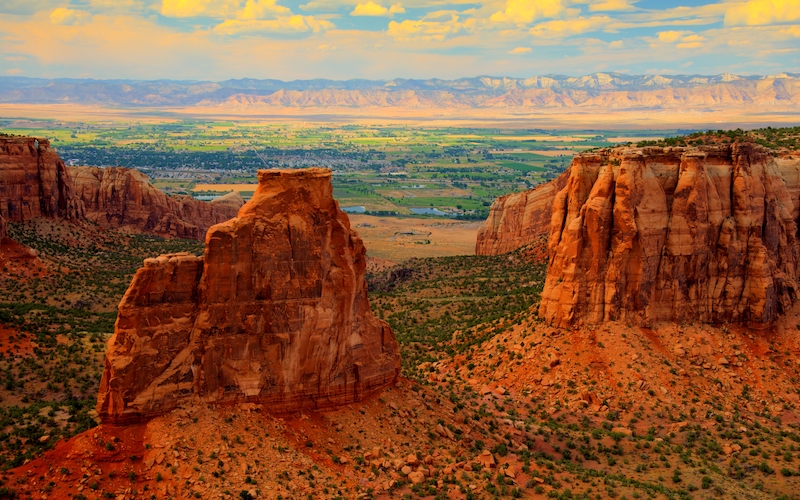
Presidents can create national monuments, but a debate rages over whether they can modify them.
Acting under the authority of the Antiquities Act of 1906, President Theodore Roosevelt designated Devils Tower as the first national monument over 100 years ago. The Act gives presidents the power to create national monuments to preserve scientific and historical sites. Congress, however, maintains the right to create, modify, and remove monuments separately under the Property Clause of the U.S. Constitution. In all, Presidents and the U.S. Congress have designated over 122 areas as national monuments.
Four agencies—the Bureau of Land Management (BLM), the U.S. Forest Service, the National Park Service, and the U.S. Fish and Wildlife Service—are tasked with preserving each monument in its original condition. Each monument has a different set of rules outlining practices that are banned or limited on monument land. These limitations are set forth in a variety of ways, including in the President’s proclamation announcing the designation of the new monument, agency policies, or management plans created by the agencies. For example, limitations on recent monuments include “barring new mineral leases, mining claims, prospecting or exploration activities, and oil, gas, and geothermal leases.”
Although the Antiquities Act is clear in granting Presidents the power to create national monuments, the Act is ambiguous as to whether they can change or remove a monument designation. This question has fueled significant controversy in the face of President Donald J. Trump’s attempts to diminish two national monuments.
During his first year in office, President Trump announced two presidential proclamations on national monuments—one reducing the size of Bears Ears National Monument and another modifying the Grand Staircase-Escalante National Monument. Yet, less than two months ago, the BLM announced management plans to help “restore use” of these monuments. Critics express concern that these lands will now be opened up for “drilling, mining, and grazing” as a result of these proclamations. The outcome of ongoing litigation in federal court, however, will determine whether the President can move forward with these plans.
This week’s Saturday Seminar focuses on current debate surrounding national monuments and who has the power to modify or rescind their status.
- Did President Trump have the authority to reduce the size of the Grand Staircase-Escalante National Monument and Bears Ears National Monument by about 85 percent? An essay in The Regulatory Review highlights the University of Utah S.J. Quinney College of Law’s John Ruple’s argument that the President does not have the authority to reduce a national monument after it is created without congressional approval. The Antiquities Act of 1906 grants the President discretionary authority to declare lands of “historic or scientific interest” as national monuments as long as those lands are owned by the federal government. But Congress never granted the President authority to reduce a monument’s size, Ruple says. Neither the Act itself—nor any legislative hearings leading to the Act’s passage—mention altering a monument once created. Rupel contends that prior modifications to national monuments by Presidents occurred only under special circumstances that do not apply to President Trump’s actions.
- Some scholars argue that, although the Antiquities Act does not expressly allow a President “to reduce or rescind a monument established by a prior President under the Act,” it does imply that a President may do so. In an article for the Florida Law Review, the University of Idaho’s Richard Seamon argues that the President has such authority because of “past presidential practice; congressional acquiescence, and official opinions of the Attorney General and the Solicitor of the U.S. Department of the Interior.” He asserts that, since the President has the power to modify or reduce monuments created under the Antiquities Act, the ability to abolish a monument entirely follows as well.
- In a comment published in the UCLA Journal of Environmental Law and Policy, Grant Horton responds to the problem of delineating presidential authority to reduce or revoke national monument designations using the oft-cited framework in Justice Robert H. Jackson’s concurring opinion in Youngstown Sheet & Tube Company v. Sawyer. According to Horton, instead of employing the Youngstown framework, courts “should broaden their view of the issue by examining how the Property Clause of the fifth amendment of the Constitution has historically been applied to Congress and the President.” Employing this strategy, Horton reasons that the President’s powers have historically been “questioned and challenged” in the context of the Property Clause. According to Horton, this trend suggests that, although discretion may be afforded to the President who made a particular monument designation, subsequent Presidents should be limited in their abilities to make changes based on what the Antiquities Act expressly permits.
- In a recent essay published by the Brookings Institution, John Hudak argues that presidents have power to diminish national monuments, but only if the monument was designated by a previous President. Looking to the text of the Antiquities Act, Hudak concedes that the Act does not explicitly grant Presidents the power to modify or diminish monuments, but he argues that diminishment power can be implied from the Act. Hudak focuses on the President’s duty under the Act to “make the area as small as is needed” and argues that this duty demonstrates the President’s ability to reduce the size of a monument established by a previous President. Hudak then explains that many Presidents have modified previous Presidents’ monuments. It is less clear, though, that the Antiquities Act would allow Presidents to modify monuments, Hudak argues. In the context of President Trump’s decision to modify Bears Ears National Monument and the Grand Staircase-Escalante National Monument, Hudak concludes that these actions were “consistent with federal law, historical precedent, and presidential power.”
- The President does not have the power to modify national monuments, argue law professors Mark Squillace, Eric Biber, Nicholas Bryner, and Sean Hecht in a recent paper published by the Virginia Law Review Online. Squillace and his coauthors look to the text of the Antiquities Act, legislative history, and prior legal opinions to conclude that the “President lacks the authority to abolish or downsize a monument, or otherwise weaken the protections afforded by a national monument proclamation declared by a predecessor.” They concede that Presidents can correct mistakes in prior proclamations. They argue, though, that courts should defer to the decisions of the President that created the original designation when making legal decisions regarding monuments. To do otherwise, they explain, would infringe on Congress’s exclusive ability to rescind or remove monuments, as well as liken the chance that future Presidents will undermine prior Presidents’ designations.
- In a recent Society & Natural Resources article, Julie Brugger uses the Grand Staircase-Escalante National Monument as a case study to track an “emerging neoliberal governmentality” in public land management. Brugger suggests that the monument’s designation by President William Clinton and subsequent reduction by President Trump reflect changing attitudes towards public land use as uninhabited space, a means of preservation, or a site to extract natural resources.
The Saturday Seminar is a weekly feature that aims to put into written form the kind of content that would be conveyed in a live seminar involving regulatory experts. Each week, The Regulatory Review publishes a brief overview of a selected regulatory topic and then distills recent research and scholarly writing on that topic.



